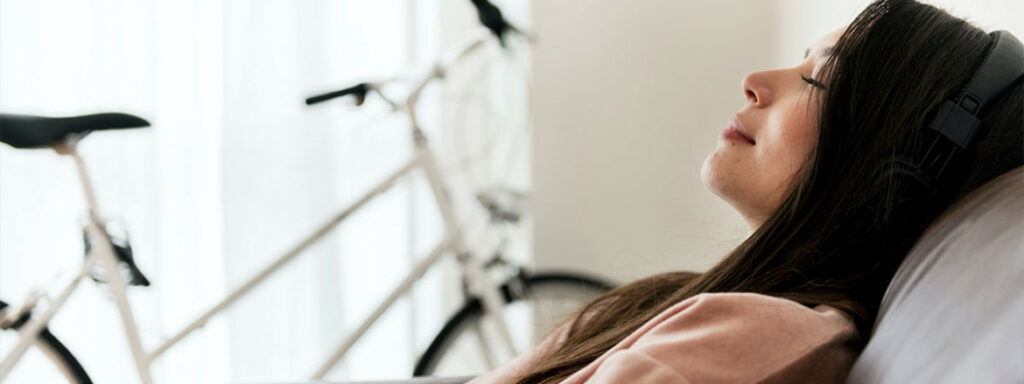In this article you can read about a number of relaxation exercises we regularly employ to let people calm down. Many of these relaxation exercises are also breathing exercises, because a breathing exercise also helps to relax. A breathing exercise is therefore often also a relaxation exercise.
Every breathing exercise describes what you have to do. Take this as literally as possible and try to exactly stick to what’s written. If you notice you’re getting dizzy or experience other complaints, it’s often a sign that your breathing before the exercise wasn’t correct. Be careful. Generally, you will notice that these relaxation exercises will make you feel more calmer and more self-aware.
If a relaxation exercise doesn’t work for you, just move on to the next one. Have fun!

Relaxation exercise 1 | Sitting in a chair
- Sit in a chair, move around a bit to make sure you’re sitting comfortably.
- Breathe calmly.
- Focus on your back and feel it touching the chair.
- Feel the contact the chair makes with your back, from the top to the bottom.
- Bring your attention to your legs.
- Feel that you’re sitting on the chair – is the chair carrying you or are you carrying the chair?
- You don’t have to do anything right now, let go of the tension and feel that the chair is carrying you.
- Take a deep breath in and gently exhale through your mouth.
- Again, a deep breath in and gently exhale through your mouth.
- Everything you notice is all right, this is your time, you don’t have to do anything, you can focus all your attention on yourself.
- Thoughts will come up, this is fine, notice them, you don’t need to do anything with them right now and let them go.
- Just let them pass.
- Bring your attention to your feet. Do they rest on the ground or do they hover?
- Whatever it is, it’s okay.
- Go to your calves, do you experience tension here? Notice it and let it go.
- Your knees. Your upper legs, do they loosely touch the chair?
- Your behind? Feel where you’re touching the chair. Let all tension in your butt go.
- Bring your attention to your stomach, how does it feel over there?
- Your chest, is there enough room there?
- Your shoulders. Do they experience tension? If so, let it go.
- Focus on your arms and hands; let all tension you experience go.
- Bring the attention to your head, are your jaws relaxed? What about your forehead? Release all the tension.
- Focus on your eyes, are your eyes at ease? Do your eyelids gently cover your eyes? Now look inwards, what do you see or notice here? What’s it like inside of you, do you feel any tension? Let it go.
- Now take a deep breath and gently exhale through your mouth. If you think you’re done, you probably have some more air to exhale, so blow it out, even more.
And again..
Now very gently open your eyes and move your arms and legs. Now, see how you’re feeling.
Relaxation exercise 2 | Breathing has to come naturally
Relaxation exercise 3 | Correct breathing
Breathing exercise: the inhalation is controlled by the sympathetic part and the exhalation by the parasympathic part of the central nervous system. When experiencing stress, the breathing is often short and shallow. The nervous system can be affected by your breathing, and the following method can be used to do so.
- Inhale for 2 seconds and exhale for 4 seconds. Repeat this 5 times.
- Inhale for 3 seconds and exhale for 6 seconds. Repeat this 5 times.
- Inhale for 4 seconds and exhale for 8 seconds. Repeat this 10 times.
The intervention is characterised by a doubled time to exhale, which eventually in step 3 leads to five breaths a minute, which is called slow breathing.
It has a calming effect on the entire body and therefore on the nervous system. This intervention forms the basis, is quick and can be applied almost everywhere. As one becomes more trained, step 1 and even step 2 can often be skipped.

Relaxation exercise 4 | Belly breathing
Belly breathing exercise: Breathing with a time interval.
For this relaxation exercise it’s wise to place your hands on your stomach to ensure you’re using belly breathing when inhaling. In a proper belly breath your belly expands when inhaling. If you experience difficulties expanding your belly, you could try to push your hands away with your belly during this breathing exercise.
Breathe in for 3 seconds, and 3 seconds out, then again 3 seconds in, and 3 seconds out. Make sure you properly distribute your breathing to ensure you use the whole allotted time to breathe in or breathe out.
- 3 s in 6 s out.
- 3 s in 6 s out.
- 3 s in 9 s out.
- 3 s in 9 s out.
- 3 s in 12 s out.
- 3 s in 12 s out.
- 3 s in 9 s out.
- 3 s in 9 s out.
- 3 s in 6 s out.
- 3 s in 6 s out.
- 3 s in 3 s out.
- 3 s in 3 s out.
Don’t push when you run out of air, but inhale again. You might not be able to make it 12 seconds in the beginning, but after a while you’ll be able to last 15 or 18 seconds.
Relaxation exercise 5 | Getting out of your head
Relaxation exercise 6 | Focus
- Comfortably sit up straight and close your eyes, or focus at one fixed point.
- Now slowly and deeply breathe in through your belly and make sure it greatly expands.
- Hold your breath for 2 seconds and now slowly exhale, let the breath flow out.
- Repeat this 10 times.
- Focus then on a point 1 cm behind your bellybutton and maintain a calm and steady breath.
- Count down from 5 to 1 and convince yourself you’re both relaxed and alert.

Relaxation exercise 7 | Through heart coherence
Moment of stress: When experiencing stress, it’s important to stabilise your energy system as quickly as possible. This saves a lot of energy and prevents additional tension. Don’t underestimate how much your flexibility is affected by frequent stress responses and realise how much loss of energy this brings about.
When to apply this? For instance after an argument, a conflict, a disappointment or a troubling email or phone conversation. These can all lead to stress reactions and bring about stress and a loss of energy.
Breathing exercise
During such moments you can reset your system by means of a breathing exercise. Whenever you feel a rise in tension, apply the following breathing exercise as soon as possible:
- Sit on a chair, calm and relaxed
- Feel how your back makes contact with the chair
- Now place your feet on the ground and place your hands on your knees
- Now breathe a little more slowly and calmly than usual
- Inhale for five seconds and exhale for five seconds (or as slowly as feels comfortable for you)
- Invoke a sense of calm and rest
Try to carry out this exercise for about 2 minutes and then observe how you feel.
Relaxation exercise 8 | Relaxation through belly breathing
Relaxation exercise 9 | Three times a day for six minutes
Perform this exercise at the following times:
- After you’ve just woken up and your head instantly switches on. Carry out the breathing exercises to take yourself to calmer waters and be able to calmly start your day.
- During the day, at a stressful time or when you notice you’ve are in too high of a gear.
- Right before sleeping, so you can go to bed with a feeling of relaxation. This will affect the quality of your night’s rest.

Focus points
- Make sure you don’t inhale too deeply. And that you don’t exhale too long and pause after your exhalation. In other words: don’t try too
- Try after every breath to really feel if it still feels comfortable and relaxed, and make sure your breath is not lagging behind, for instance because you’re exhaling for too long and pausing after the exhalation. Consciously working on your breathing and practising is at least as valuable as the results.
- Give yourself time to learn how to feel what a calm and relaxed breath feels like again. This could easily take a number of days, because your body has gotten used to being in the wrong ‘gear’.
Relaxation exercise 10 |

Training and coaching
Milltain provides training and coaching for private individuals and organisations. Our team consists of 35 coaches and trainers who have now helped thousands of people struggling with stress and burnouts.
Can we help you?
Leave us your information and one of our coaches will contact you in 24H

Milltain for private individuals:
Are you stuck in life because of stress or a burnout? We developed an effective online programme that is fully focused on the complete recovery from a burnout. More than 2000 people have successfully completed this training!
Movement and nature play prominent roles in this training. Recovery is a process that contains peaks and troughs, and that’s something we know all about. Our highly experienced coaches provide you with active support.
Learn more: Stress and burnout coaching
Stress & burnout coaching; for 100% recovery!
Reducing stress and recovering from burnout is simply incredibly difficult. The coaches at Meulenberg Training & Coaching understand exactly what you are going through and know how tough it can be. They have often experienced it themselves! With their years of experience and expertise, they are ready to help you step by step toward a full recovery. The results of our one-on-one coaching and absenteeism training will benefit you for a lifetime!






